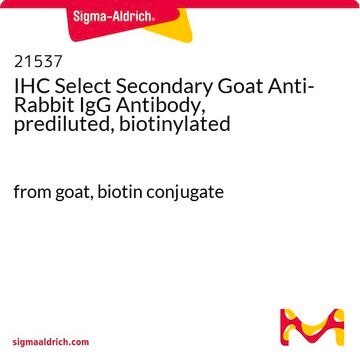SAB4200866
Anti-Pseudomonas aeruginosa antibody produced in rabbit
IgG fraction of antiserum
Seleccione un Tamaño
Seleccione un Tamaño
About This Item
Productos recomendados
origen biológico
rabbit
Nivel de calidad
forma del anticuerpo
IgG fraction of antiserum
tipo de anticuerpo
primary antibodies
Formulario
liquid
reactividad de especies
Pseudomonas aeruginosa
envase
pkg of 100 μL
pkg of 25 μL
concentración
~1 mg/mL
técnicas
immunoblotting: 1:10,000-1:20,000 using P.aeruginosa lysate
indirect ELISA: 1:5000- 1:0,000 using whole dead P.aeruginosa bacteria for coating
Condiciones de envío
dry ice
temp. de almacenamiento
−20°C
modificación del objetivo postraduccional
unmodified
Descripción general
patients every year and are accounted for around 90,000 deaths annually.3
It forms highly resistant biofilms on human tissues such as the lungs of CF patients or medical surfaces. Once P. aeruginosa infection is established it is extremely hard to eradicate.3
The genome of P. aeruginosa encodes a vast arsenal of virulence factors. However, the P. aeruginosa isolated from chronic infections expresses less virulence factors in comparison to isolates from acute infections but more readily form biofilms.1,4-6
Especificidad
Aplicación
Acciones bioquímicas o fisiológicas
Antibiotic resistance to many classes of antibiotics is a major challange in P. aeruginosa treatment. P. aeruginosa possesses several resistance mechanisms such as, low permeability of the outer membrane,
expression of membrane efflux (Mex) pumps, and ß-lactamase and AmpC that hydrolases ß-lactam antibiotics such as, penicillin9. In addition, as a result of genetic transfer new resistant strains emerge constantly. Therefore, finding new prevention and treatment strategies for P. aeruginosa infection is of high importance.1
Forma física
Almacenamiento y estabilidad
Cláusula de descargo de responsabilidad
¿No encuentra el producto adecuado?
Pruebe nuestro Herramienta de selección de productos.
Código de clase de almacenamiento
12 - Non Combustible Liquids
Clase de riesgo para el agua (WGK)
WGK 1
Punto de inflamabilidad (°F)
Not applicable
Punto de inflamabilidad (°C)
Not applicable
Elija entre una de las versiones más recientes:
Certificados de análisis (COA)
¿No ve la versión correcta?
Si necesita una versión concreta, puede buscar un certificado específico por el número de lote.
¿Ya tiene este producto?
Encuentre la documentación para los productos que ha comprado recientemente en la Biblioteca de documentos.
Active Filters
Nuestro equipo de científicos tiene experiencia en todas las áreas de investigación: Ciencias de la vida, Ciencia de los materiales, Síntesis química, Cromatografía, Analítica y muchas otras.
Póngase en contacto con el Servicio técnico








